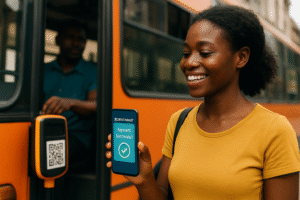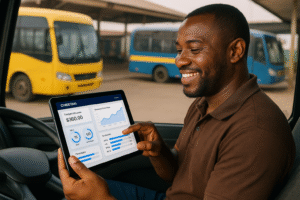Introduction
Public transport in Africa is undergoing a digital shift. As urban populations grow and the demand for transparent fare collection rises, micro fare solutions like Cheetah are bridging the gap between affordability and innovation. By enabling commuters to pay small amounts seamlessly, these systems are reshaping how millions of Africans access buses, minibuses, and informal transit services.

Understanding Micro Fare Technology
Micro fare payments refer to small, flexible digital transactions designed for low-cost mobility services. Instead of relying on cash or large prepaid cards, passengers can pay:
- Per trip,
- Per distance traveled, or
- Even in fractional amounts for connecting journeys.
This technology thrives on mobile integration, making it accessible to both smartphone users and basic feature phone owners.
In Africa, where financial inclusion is still growing, micro fare payments bring an inclusive model that empowers unbanked commuters.
The Rise of Digital Wallets and QR Code Payments
One of the biggest enablers of micro fare systems is the rapid adoption of digital wallets and QR code technology.
According to GSMA Mobile Money Stats, Africa leads the world in mobile money accounts, with over 400 million active users. This provides the perfect ecosystem for:
- Instant top-ups via mobile money services like M-Pesa, MoMo, or Paga.
- Offline-capable QR codes, allowing quick fare validation without requiring constant internet access.
- Secure, traceable payments, reducing theft and fare evasion.
By linking digital wallets to transport services, operators can unlock new revenue streams while passengers enjoy cashless convenience.
How Cheetah Enables Seamless Intermodal Journeys
African commuters often rely on multiple transport modes—a bus, then a minibus, then a motorcycle taxi. Traditionally, this meant separate cash payments for each leg of the journey.
Cheetah solves this pain point by offering:
- One unified payment account for different modes.
- Dynamic fare aggregation, so commuters can move seamlessly without multiple transactions.
- Real-time updates, helping passengers plan their trips better.
For example, a commuter in Lagos can pay for a BRT bus and then hop on a keke (tricycle) without needing new cash.
(Learn more on How Cheetah Works)
Transparency and Traceability for Governments
For city governments and transport authorities, micro fare payments create accountability.
- Digital records make it easier to analyze passenger flow.
- Tax and regulatory compliance improve since payments are traceable.
- Subsidy programs can be better targeted to low-income groups.
This shift reduces informal cash leakages and allows governments to plan sustainable urban mobility strategies with accurate data.
A Sustainable Mobility Strategy for African Cities
Micro fare payments are not just about convenience—they are a strategic step toward sustainable urban transport.
- Less cash handling reduces security risks.
- Faster boarding times ease congestion at bus stops.
- Digital footprints help planners design eco-friendly transport routes.
As more cities embrace smart mobility, micro fare systems like Cheetah will form the backbone of integrated, sustainable transport ecosystems.
(See what our riders are saying in User Testimonials)
Conclusion
The future of public transport in Africa is cashless, inclusive, and data-driven. By leveraging micro fare payments, cities can make commuting more affordable, operators can secure their revenues, and commuters can enjoy stress-free, seamless journeys.
Cheetah is at the forefront of this transformation, connecting millions of Africans to smarter mobility solutions.
👉 Ready to experience the future of transport? Discover How Cheetah Works


